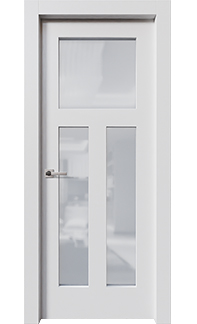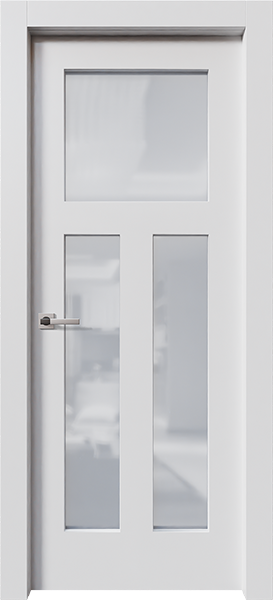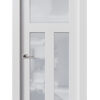Description
THE DOOR NAME ORIGIN – “SHAKER STYLE 3 CRAFT LIGHT LAMI GLASS”
This interior door is similar to its 3-panel Craft counterpart in the series except for the 3 lami glass lights replacing the 3 panels.
The sentiment is largely the same, though. The design was inspired by the Shaker movement in particular, which was, when all is said and done, New England’s answer to “new luxury.”
Two revolutions – American and French – effectively ended the final stage of the Baroque period known for its rococo extravagance. The income gap began to shrink, the middle class finally came into its own, and urban architecture began to take into consideration, not just the needs of the aristocracy, but those of other people as well. The face of every major city on the planet started to change. Whereas in the past a city was an area with a few landmarks (churches and palaces, mostly) surrounded by largely unattractive make-shift housing cobbled together every which way, the new construction wave brought the Neoclassical residential building to the scene. Elegant paved streets and avenues appeared with structures of brick and limestone. Gas light and soon after electricity illuminated civic centers at night. Before long, however, the new wealthy class of industrialists found that the royal luxury of old wasn’t all bad after all.
Baroque themes began to reappear in urban and countryside architecture little by little. The Shakers would have none of it. A style was invented whose purpose was to keep the elegance while eschewing all excess.
Lest we forget: as all Almes Doors, this interior door does come with all the usual great hardware features.
(It is worth noting that the Shaker culture encouraged and promoted its innovators. Sarah “Tabitha” Babbitt, one of the original American Shakers, is credited with the invention of the first circular saw (for use in a saw mill; this was in the year 1813. The cut nail is often ascribed to her as well).
It started with furniture, but soon elements of the Shaker style were found in other design elements (including, of course, interior doors). Craftsmen advocating the new approach traveled beyond New England, and soon the Shaker style was gaining popularity across the entire continent.
One of the intriguing design features of this particular interior door – a “craft” item – is that, because of its elegant simplicity, it can fit seamlessly into any type of decor, contemporary or traditional without losing any of its character.
The Italian-made 3D-adjustable concealed hinges will make installation easy and quick, as well as add to the overall elegance of this product. The soundless magnetic lock is known for its dependability. The automatic sweep enhances the wonderful sound-proofing and thermal insulation qualities, which is to say it will ensure privacy as well as significantly reduce your electrical bill.
… Fair is fair. The Shaker movement did appear in Eighteenth Century England first. Even back then, they already espoused egalitarian ideals, with women taking on spiritual leadership roles alongside men. That said, the first furniture (and interior door) designers came from New Lebanon, New York. Next time you’re up there, it might be a good idea to examine what still remains of their architecture (including, of course, the interior doors).
FINISH: PRIMED
The advantages of this approach – of this type of interior door finish – are fairly obvious. Pick a color, any color that suits your projects best. Mix and apply. Re- coat whenever you feel it is necessary to do so. Touch it up. It gives you, the proud owner of these interior doors, complete freedom of choice, and the significant savings, especially where it comes to bulk orders, can be a true source of joy.
As Kurt Vonnegut mentions in one of his novels (Bluebeard, unless I’m mistaken … check it out when you get a chance), the thrill of laying on colors is a large part of the artist’s professional satisfaction. In other words, a keen pleasure.
When back in the remote past visual arts became a field dominated by professionals rather than hobbyists, the main problem of “just laying on paint” became obvious: you can’t.
The medium of choice back then was egg tempera, a permanent, fast-drying substance consisting of colored pigments mixed with a water-soluble binder medium, usually glutinous material such as egg yolk. Portraits and ornaments were executed in this medium, and the wood panel was the surface of choice. One of tempera’s interesting features is that it is not as easily absorbed by wood as other mediums. Some sort of primer was necessary, of course, but pretty much any substance that dried evenly could be used.
The drawbacks of tempera, or pintura al temple, as the Spanish call it, only became obvious with the advent of the Renaissance, when the leading representatives of the trade turned to oil (and interior doors suddenly became a great deal less crude, but that’s a story for another day).
Oil painting is the process of “painting with pigments with a medium of drying oil as the binder.” Commonly used types include linseed (highly preferable in art, though not necessarily in interior doors, mind you), poppy seed, walnut, and safflower.
Today, five hundred years later, it is safe to say that oil is more versatile than pintura al temple – by orders of magnitude. Specifically, the contrasts achieved through the former are much greater, the darks are far deeper, and three- dimensional, highly realistic images are much easier to achieve. Next time you visit a museum, take a closer look at pintura al temple portraits. All of them, without exception, come off as a bit “flat” as opposed to their latter-day counterparts.
Also, where glazing is concerned …
Glazing: a painting technique in which a transparent layer, with just a touch of pigment, is laid over a previously painted surface, allowing light to travel through the glaze and be reflected back off of the opaque layer below. Gentle shadows, subtle changes of color, smooth transitions – all these can be achieved through glazing, which was used by all artists up until the middle of the Nineteenth Century, when artist tubes were invented, revolutionizing the field, and other techniques began to be explored.
Tempera enthusiasts (it takes all kinds to make a world) will assure you that glazing is not just possible in pintura al temple but is actually the basis of the whole enterprise. Well, what are you going to do? They’re enthusiasts.
Anyway, la peinture à l’huile, as the French call it, re-introduced the ancient problem of most surface’s propensity to absorb dipingere, as the Italians call the stuff. Wood or canvas, it is all the same: you’re not going to get very far without a good primer.
Experiments were conducted, and soon rabbit skin glue emerged as the least expensive and most effective solution. It was easy to apply. It dried evenly. It made the application of the l’huile stuff on top of it a walk in the park.
There were drawbacks. Today, rabbit skin glue is considered to be a major cause of cracking by most modern conservators. (Remember, when you visited the Metropolitan Museum of Art – and did you see those interior doors? … some of them are quite something … – most “old masters” pictures are completely covered with a cobweb of cracks? There you go). Because the glue is hygroscopic, it continually absorbs moisture from the atmosphere, causing the glue to swell and shrink as ambient humidity levels change. Over many humidity cycles, this repeated flexing causes the brittle oily layers to crack.
To combat this problem, modern primers are made of acrylic materials which are guaranteed not to cause any damage to the dipingere. No bubbling, no cracks. Your interior doors are safe.









